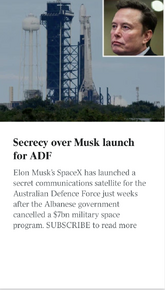Some very interesting points are made in this video. I'm not sure how accurate the figures are, but maybe the Defence review could have been done differently. These are eye watering figures, particularly the Hawkei vehicles and the new C130J30s.
He does miss some points on costings.
First up - I'm not a huge fan of Hawkei, but I get it the idea. A protected vehicle is so much better than using a G-wagon, especially when its just a small element (like a sub-unit HQ or similar). You can quibble about size and the dumbness is not fitting a spare to the vehicle (necessitating the trailer), but as a PMV-L it's perfectly fine. The issue about cost is harder though. Is it cheaper than a JLTV? Yes. But where does the money for a JLTV go? Oshkosh. Where does the money for a Hawkei go? Bendigo. The Treasury have found that for every dollar the government spends in Australia, they get $3-4 back in return as it moves through the system.
Does that mean we should just build Hawkei for no reason? No. We should look at minimum viable capability and stop there. But it does highlight another issue - why did the JLTV not select the Hawkei or the US Army the Bushmaster. And for that, we need to look further back The Bushmaster was the only truck capable of protected mobility being produced at scale when the US suddenly ID'd the need for one in AFG/Iraq. They came to us and ask for multiple thousands - and we said no. So they did their own. Sound familiar (looks at Nulka, Loyal Wingman, Wedgetail, etc)? If we had our act together back then, even providing them under license for production in the US, we'd be having a very different Hawkei chat.
Secondly, he has done the 100% amateur act of dividing the total project cost ($10b) by number of airframes (20) to say cost per airframe ($500m / C-130J). It's so wrong that almost anyone who has been in the area for longer than 6 weeks understands that the acquisition project buys more than major platforms. This $10b is adding to infrastructure, spares, radios, training, workforce...a whole bunch of stuff. I'm sorry, but anyone who does this simply cannot be taken seriously on any finance topic.
Other
minor (it was minor until the 2025 onwards dumbness) quibbles:
- complaining that purchase in the early 2010s doesn't match current strategic view
- argument over the LHD has long gone, and the DSR's comments on small was not in relation to LHDs (and for combat ships has been disproven again),
- confusing the littoral craft with LHDs,
- in general arguing the LHDs have added very little capability to the ADF
- Growlers are too niche and not value for money (literally the only time I have heard that said, including from RAN and ARA peeps)
- no comments on the Land C4 projects?
- no critique of the F-35 purchase (despite not really being capable of combat yet and arguable too many, especially with their cost)
- misunderstanding of who pays what for cyber defence (it isn't all Defence)
- confusing Triton and Peregrine (they don't do similar roles, nor are they interchangeable)
- Ghost Bat....... hmmmm.....
- Upgrades/extensions can be acquisition or sustainment, it doesn't matter. There is no 'belong', it depends on the size and scope.
- There is no role for a MBT in a strategy of denial? FFS - this is a basic misunderstanding of their role. They are an essential contributor to such a strategy.... This here? This highlights the issue with amateurs talking about this stuff.
Overall, the focus on major platforms only misses much of the ways to look at costing. Remember, there are roughly 300-500 items in the IIP at any one stage - focusing on just these projects misses most of the discussion. It's a perfectly fine video with the usual ignorance of details and financial misunderstandings. Some of those are fine and understandable (especially more recent items noting the tighter control on public release), but some of the earlier stuff is either ignorant or show a lack of research. That, combined with the C-130J error, means it's simply not worth the time

